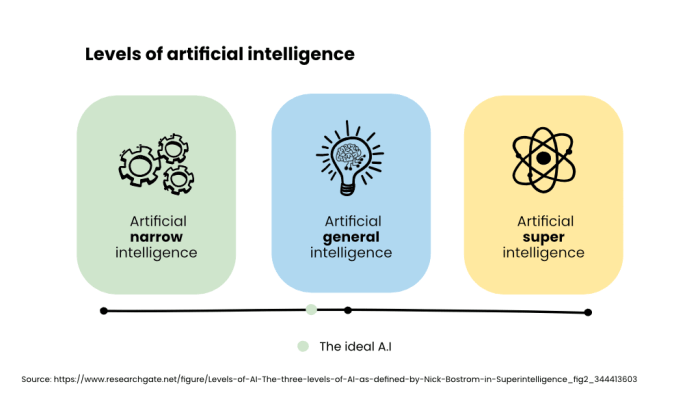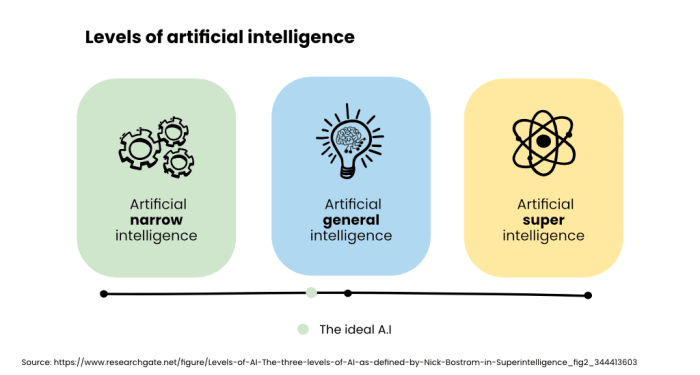Delving into Understanding Different Levels of AI: From Narrow to Superintelligence, this introduction immerses readers in a unique and compelling narrative, with a focus on the progression of AI from narrow to superintelligence. It explores the fascinating capabilities and limitations of AI at different levels, offering a comprehensive view of this rapidly evolving technology.
Understanding Narrow AI

Narrow AI, also known as weak AI, refers to AI systems that are designed to perform specific tasks or solve particular problems. These systems are not capable of general intelligence or understanding beyond their programmed functions. Examples of narrow AI include virtual assistants like Siri or Alexa, recommendation algorithms on streaming platforms, and facial recognition software.
Limitations of Narrow AI
Narrow AI is limited in the tasks it can perform due to its specialized nature. While it can excel at specific tasks within a defined scope, it lacks the ability to adapt or generalize its knowledge to new situations. This means that narrow AI is not capable of learning or evolving beyond the specific functions it was designed for.
- Narrow AI is designed to operate within a specific set of parameters and cannot handle tasks outside of those parameters.
- These systems lack understanding or awareness of the context in which they are operating, leading to limitations in their problem-solving abilities.
- Narrow AI may struggle with tasks that require common sense reasoning or human-like intuition, as they are based on predefined rules and patterns.
Exploring General AI
General AI, also known as artificial general intelligence, refers to AI systems that have the ability to understand, learn, and apply knowledge across a wide range of tasks, similar to human intelligence. In contrast to narrow AI, which is designed for specific tasks, general AI has the potential to perform any intellectual task that a human can.
Capabilities of General AI
- General AI can adapt to new situations and solve complex problems without specific programming.
- It can understand natural language, learn from experience, and apply knowledge to various domains.
- General AI has the capacity for abstract thinking, creativity, and self-improvement.
Advancements in General AI
In recent years, there have been significant advancements in the development of general AI:
- Research in reinforcement learning has led to AI systems that can learn and improve continuously through trial and error.
- Advancements in natural language processing have enabled AI models to understand and generate human-like text.
- Projects like OpenAI's GPT-3 have demonstrated the potential of large-scale language models to perform a wide range of tasks with minimal human supervision.
Diving into Artificial Narrow Intelligence (ANI)
Artificial Narrow Intelligence (ANI) is a subfield of AI that focuses on machines designed to perform specific tasks or solve particular problems. ANI is often used interchangeably with the term "narrow AI," but there is a subtle difference between the two.
Differentiate between ANI and narrow AI
ANI specifically refers to machines that are built to excel at a narrow set of tasks, while narrow AI encompasses all AI systems that are focused on a single task or a specific domain. In essence, ANI is a subset of narrow AI, highlighting machines that are better than humans in a particular area.
Discuss how ANI refers to machines that are better than humans at some specific tasks
ANI is designed to outperform humans in a narrowly defined task or set of tasks. These systems are trained and optimized to excel in a specific domain, such as image recognition, language translation, or playing strategic games like chess or Go.
While ANI may surpass human capabilities in these areas, they lack the general cognitive abilities and adaptability of human intelligence.
Provide real-world examples of ANI in use today
- Virtual assistants like Siri, Alexa, and Google Assistant are examples of ANI that can understand and respond to voice commands, perform tasks like setting reminders, playing music, or providing information.
- Recommendation systems used by streaming services like Netflix or e-commerce platforms like Amazon leverage ANI to analyze user preferences and suggest personalized content or products.
- Autonomous vehicles rely on ANI to navigate roads, interpret traffic signals, and make real-time decisions to ensure safe driving.
Unpacking Artificial General Intelligence (AGI)
Artificial General Intelligence (AGI) refers to the concept of creating machines that possess the ability to understand and learn any intellectual task that a human can. Unlike Narrow AI, which is focused on specific tasks, AGI aims to mimic the broad cognitive abilities of humans.
Challenges in Developing AGI and Achieving Human-like Intelligence
Developing AGI poses several challenges, primarily due to the complexity of human intelligence. Some of the key obstacles include:
- The need for advanced learning algorithms that can adapt to various scenarios and tasks.
- Understanding the nuances of human cognition and replicating them effectively in machines.
- Ensuring ethical and responsible development of AGI to prevent unintended consequences.
Insights on Research Efforts Towards Achieving AGI
Researchers are actively working towards achieving AGI through various approaches, such as:
- Exploring deep learning techniques to enhance machine learning capabilities.
- Studying neuroscience to gain a better understanding of human brain functions and intelligence.
- Collaborating across disciplines to combine expertise in computer science, cognitive psychology, and robotics.
Considering Artificial Superintelligence
Artificial superintelligence refers to AI systems that surpass human intelligence in all aspects, including cognitive abilities, problem-solving skills, and creativity. These systems are theoretically capable of outperforming humans in every intellectual task, leading to unprecedented advancements in various fields.
Defining Artificial Superintelligence
Artificial superintelligence (ASI) represents the pinnacle of AI development, where machines possess cognitive abilities far beyond human capacity. Unlike narrow or general AI, which are designed for specific tasks or mimic human intelligence, ASI has the potential to exceed human intellect exponentially.
Ethical Implications and Risks
- One of the major ethical concerns surrounding superintelligent AI is the loss of control over these systems. As ASI evolves and becomes more autonomous, the risk of unintended consequences or misuse increases significantly.
- The potential for ASI to make decisions independently, without human intervention, raises questions about accountability and the ethical framework within which these systems operate.
- There is also a fear of ASI surpassing human comprehension, leading to a scenario where humans are unable to understand or control the actions of superintelligent machines.
Societal Impact of Superintelligent AI
- Superintelligent AI could revolutionize industries such as healthcare, finance, and transportation by offering unparalleled efficiency and innovation.
- ASI has the potential to solve complex global challenges like climate change, resource scarcity, and healthcare disparities through advanced problem-solving capabilities.
- However, the widespread adoption of ASI may also lead to job displacement, economic inequality, and social unrest as human roles are replaced by superintelligent systems.
Last Word
In conclusion, Understanding Different Levels of AI: From Narrow to Superintelligence provides valuable insights into the intricate world of artificial intelligence. From the specialized skills of narrow AI to the potential of superintelligence, this discussion sheds light on the diverse capabilities and implications of AI advancement.
FAQ Explained
What distinguishes narrow AI from general AI?
Narrow AI is designed to excel at specific tasks, while general AI can potentially perform any intellectual task that a human can.
How is artificial superintelligence defined?
Artificial superintelligence refers to AI that surpasses human intelligence and has theoretical capabilities beyond our understanding.
What are the ethical implications of superintelligent AI?
Superintelligent AI poses potential risks and ethical concerns due to its advanced capabilities and potential societal impacts.



